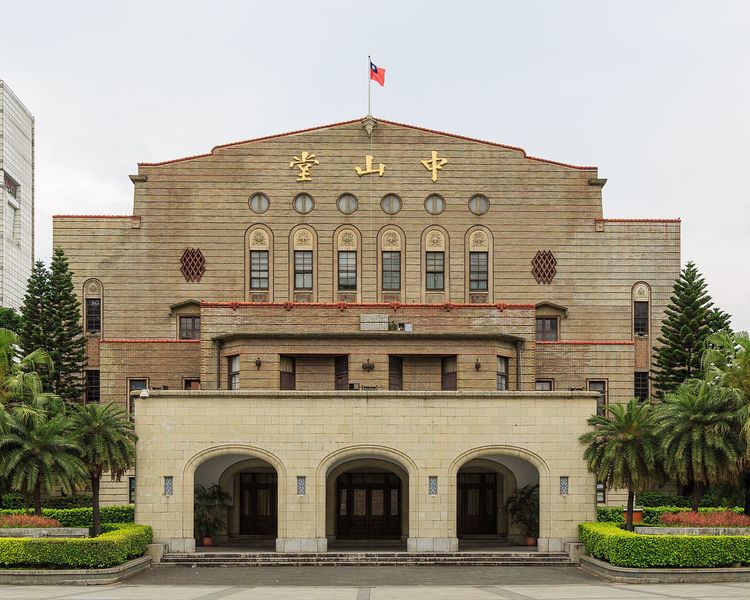Alternative names Chungshan Hall Construction started November 23, 1932 Opened 26 November 1936 Architect Kaoru Ide | Completed November 26, 1936 Phone +886 2 2381 3137 | |
 | ||
Hours Open today · 9AM–5PMMonday9AM–5PMTuesday9AM–5PMWednesday(Qingming Festival)9AM–5PMHours might differThursday9AM–5PMFriday9AM–5PMSaturday2–4PMSunday2–4PMSuggest an edit Similar Red House Theater, Ximen Station, National Taiwan Museum, Taipei Futai Street Mansion, Taipei Prefecture Capital N | ||
The light sculpture show west side grand theater at zhongshan hall taipei taiwan
Zhongshan Hall (Chinese: 中山堂; pinyin: Zhōngshān Táng) is a historical building which originally functioned as the Taipei (Taihoku) City Public Auditorium(public hall). It is located at 98 Yanping South Road in the Ximending neighborhood of the Zhongzheng District, Taipei, Taiwan. In 1992, it was recognized by the government as a historic site.
Contents
- The light sculpture show west side grand theater at zhongshan hall taipei taiwan
- 3d light show projected on zhongshan hall for 2017 taipei lantern festival
- History
- Current use
- Notable features
- Accessibility and transportation
- References
3d light show projected on zhongshan hall for 2017 taipei lantern festival
History
As a tribute to mark the ascension of the Japanese Emperor Showa in 1928, the Japanese government in Taiwan dismantled the Qing dynasty government office in Taipeh (Taipei) and began the plan to erect the Taihoku City Public Auditorium (臺北公會堂, Taihoku Kōkaidō). Construction began on November 23, 1932 and completed on November 26, 1936. Ide Kaoru, the main architect serving as Chief Engineer in Taiwan under the Japanese government, used the full cost of 980,000 Yen and 94,500 workers.
The four-story steel structure of the building was designed to be fire-resistant and to withstand severe earthquakes and typhoons. The original building was faced in light green tile to make it less visible to aerial bombers. The windows are adorned with classical designs in a Spanish Islamic style. With 44,179 square feet (4,104.4 m2) for the ground floor, the total area of the City Public Auditorium was 113,750 square feet (10,568 m2), making it the fourth largest city Public Auditorium in Japan at that time. It was smaller than only the City Public Halls of Tokyo, Osaka, and Nagoya.
After Taiwan's handover to the Republic of China in 1945 after World War II, the Chief of Taiwan Provincial Administrative Office, Chen Yi represented the Allies and accepted a formal surrender from the Japanese. The surrendering Japanese commander was Ando Rikichi, Japanese Governor of Taiwan. The former Taihoku City Public Auditorium was renamed Chungshan (Zhongshan) Hall in honor of Sun Yatsen and functioned as an official meeting place under the Chinese government.
Zhongshan Hall has always been one of the formal reception areas for welcoming foreign guests and diplomats. Former guests have included US President Richard Nixon, Korean President Syngman Rhee, President of South Vietnam Ngo Dinh Diem, Philippine President Carlos P. Garcia, Iranian King Mohammad Reza Pahlavi, and others. Zhongshan Hall has also hosted memorial ceremonies such as the signing of the Sino-American Mutual Defense Treaty and three formal inauguration ceremonies of the second, third, and fourth presidency and vice-presidency of the Republic of China.
Current use
The hall has several auditoriums currently used for arts performances such as chamber and orchestral music, traditional Chinese music, voice/choir, opera, dance, ceremonies, and exhibits.
Notable features
Accessibility and transportation
By public transit, take Taipei Metro Ximen Station Exit No. 5 to access the hall. There is also an underground parking lot.
